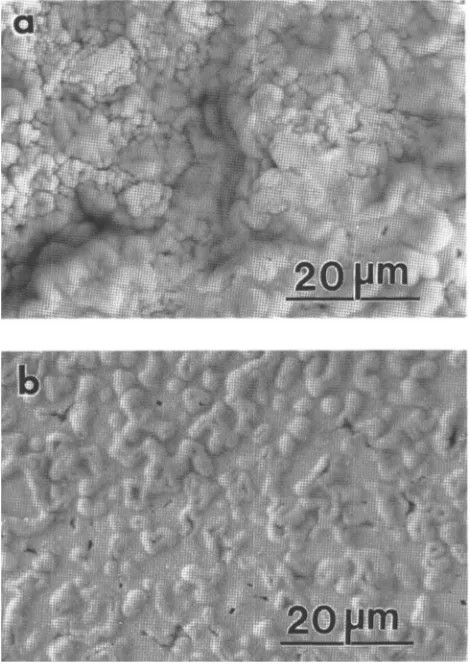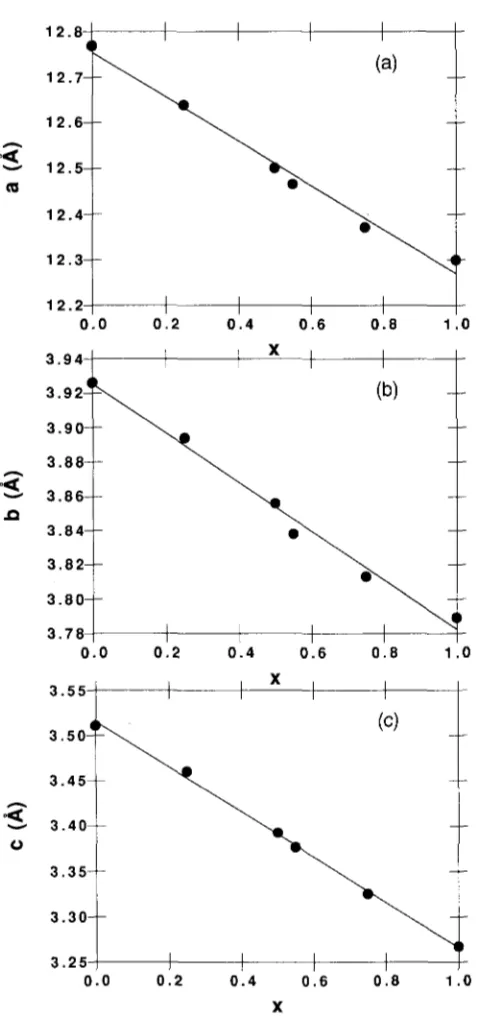Materials Science and Engineering Publications
Materials Science and Engineering
5-1992
Synthesis and characterization of ceramic
(Sr1−xCax)2 CuO3
Ming Xu
Iowa State University
Edwin T. Voiles
Iowa State UniversityL. Scott Chumbley
Iowa State University, chumbley@iastate.edu
Alan I. Goldman
Iowa State University, goldman@ameslab.gov
D. K. Finnemore
Iowa State University, finnemor@ameslab.gov
Follow this and additional works at:
http://lib.dr.iastate.edu/mse_pubs
Part of the
Metallurgy Commons
The complete bibliographic information for this item can be found at
http://lib.dr.iastate.edu/
mse_pubs/133
. For information on how to cite this item, please visit
http://lib.dr.iastate.edu/
howtocite.html
.
Synthesis and characterization of ceramic (Sr1−xCax)2 CuO3
Abstract
Ceramic (Sr1−xCax)2CuO3samples have been prepared withx= 0.00, 0.25, 0.50, 0.55, 0.75, and 1.00 in order
to study the change in lattice constants with the ratio of Sr/Ca. This phase is frequently an impurity phase in the fabrication of Bi–Sr–Ca–Cu–O superconductors, and it is important to be able to connect the lattice constants with stoichiometry. The behavior of the lattice constants closely follows Vegard's law.
Keywords Ames Laboratory
Disciplines Metallurgy
Comments
This article is fromJournal of Materials Research7 (1992): 1283-1285,doi: 10.1557/JMR.1992.1283. Posted with permission.
Synthesis and characterization of ceramic (Sri
Ming Xu, E. T. Voiles, L. S. Chumbley, A. I. Goldman, and D. K. Finnemore
Ames Laboratory, United States Department of Energy, Department of Physics, and Department of Materials Science and Engineering, Iowa State University, Ames, Iowa 50011
(Received 7 October 1991; accepted 19 December 1991)
Ceramic ( S r ^ C a ^ C u C ^ samples have been prepared with x = 0.00, 0.25, 0.50, 0.55, 0.75, and 1.00 in order to study the change in lattice constants with the ratio of Sr/Ca. This phase is frequently an impurity phase in the fabrication of B i - S r - C a - C u - 0 superconductors, and it is important to be able to connect the lattice constants with stoichiometry. The behavior of the lattice constants closely follows Vegard's law.
I. INTRODUCTION
Since the discovery of high Tc B i - S r - C a - C u - 0
superconductors, there has been considerable interest in the many phases that form at higher temperatures during the melt-texturing process. Second phase precipitates, for example, could be used as pinning centers in the superconducting Bi (2212) or Bi (2223) phases. For the Y (123) system the 211 phase seems to be the precipitate of choice for flux pinning, but no corre-sponding phase has emerged for Bi (2212). It has been shown1 that Bi-based compounds have a very compli-cated melting process with more crystalline phases than in the superconducting Y (123) systems. Roth et al. have systematically studied the phase equilibria and crystal chemistry in the binary and ternary ceramic com-pounds related to B i - S r - C a - C u - 0 systems.23 Schulze
et al. have investigated phase diagrams in the system of
B i2O3- S r O - C a O - C u O for temperatures between 750
and 860 °C in air4'5 and have mapped out the phases for Sr/Ca ratios of 1/1 and 2 / 1 .
In flux pinning studies, it was found that the intragrain critical current density could be enhanced by introducing Ca2Cu03 as the pinning center into
the B i - S r - C a - C u - 0 system.6 In recent studies of high temperature x-ray diffraction,1-7 it has been shown that upon melting Bi (2212) powder at least three different insulating phases appear in the liquid in the 870 °C to 890 °C temperature range, (Sr1_A:Ca^)CuO2,
(Sr1_A:CaA:)2CuO3, and (Sr, Ca)O, during the melting
process. During freezing, samples show a great deal of supercooling of the Bi (2212) liquid with nucleation of ( S r ^ C a ^ C u O s being favored over ( S r ^ C a J C u C ^ and ( S r ^ C a ^ O . Although it has been claimed that the (Sri_xCa^)2Cu03 system forms a complete series of solid
solution,2'4 detailed description and data, such as lattice parameters and their relations to the ratio of Sr/Ca, have not been reported to our knowledge. High temperature x-ray experiments show that various solid solutions can be formed with different ratios of Sr/Ca during the heating and cooling processes. Thus, information of crystalline ( S r ^ C a ^ C u O s is necessary to identify the
phases appearing in B i - S r - C a - C u - 0 compounds at higher temperatures (850-890 °C).
The purpose of this work is to study the phase formation and crystalline properties of ( S r ^ C a ^ C u C ^ . Ceramic samples (Sr1_xCaA:)2Cu03 with x = 0.00, 0.25,
0.50, 0.55, 0.75, and 1.00 have been prepared. The phases present in these samples have been determined by x-ray diffraction and scanning electron microscopy (SEM). Energy dispersive spectroscopy (EDS) and in-ductively coupled plasma (ICP) techniques have also been used to determine the chemical composition in ceramic samples of (Sr1_J-Cax)2Cu03. The relationships
between the lattice constants and the ratios of Sr/Ca have been obtained from x-ray diffraction data.
II. EXPERIMENTAL DETAILS
The ceramic compounds were prepared by a solid reaction technique. Starting materials of SrCO3, CaCO3,
and CuO were weighed with atomic ratios of x = 0.00, 0.25, 0.50, 0.55, 0.75, and 1.00. The weighed powders of 5 g for each composition were thoroughly ground by a mortar and pestle for about 20 min. The mixed powders were placed in an A12O3 crucible and calcined
at 800 °C for 12 h in air followed by a furnace cool. The calcined powders were reground and the calcination pro-cesses were repeated two times at 870 °C and 900 °C. The calcinated powders were pressed into pellets with diameters of about 12 mm using a uniaxial pressure at 4000 psi. The pellets were sintered at 950 °C in air for 12 h. The sintered pellets were then broken and ground into powder. The sintering procedure was repeated at 970 °C followed by a furnace cool.
X-ray diffraction data were taken using a Philips powder diffractometer with Cu Ko radiation operating at
40 kV and 20 mA. Microstructure and phase composi-tion were examined by a Cambridge S. 200 scanning electron microscope (SEM) equipped with a Tracor-Northern energy dispersive spectrometer (EDS) and operated at 15 kV. Standards for analysis were deter-mined by chemical analysis using the inductively coupled plasma (ICP) technique.
M. Xu et al.: Synthesis and characterization of ceramic (Sr1_xCax)2Cu03
III. RESULTS AND DISCUSSION
Samples studied in this work readily formed nearly phase-pure ceramic. Analyses by IPC and EDS do not indicate the presence of any impurities. The chemical analyses also show that there is no variation in the stoichiometry of each sample from the starting com-position, and SEM examination of portions of each sample using backscatter imaging reveals no additional phases. Therefore, we have obtained the samples with compositions very close to the ideal stoichiometry in the ceramic (Sr1_xCaA.)2Cu03. X-ray diffraction results
show that almost all diffraction peaks result from a single phase with very small amounts of impurity phases, such as CuO, in the sample of Ca2Cu03. Very weak
peaks belonging to (Sr, Ca)CuO2 phases have also been
observed by x-ray diffraction in two of the ceramic (Sri_xCa^)2Cu03 with x = 0.50 and 0.55. The SEM
photographs of the samples with x = 0.25 and 0.50 are shown in Fig. 1. The SEM pictures also indicate that these samples are essentially single phase.
Both XRD and SEM results show that the Ca can replace the Sr position in the ceramic (Sr!_xCax)2CuO3
'f> i A / 4
•Jfnis^:1 -1
- ' • '. r. ' '..
v-; : "y-'
• " : ' . . : - ;: ;
over a wide region of Sr/Ca ratio or composition (x). The unit cell of each composition becomes larger as more Sr atoms substitute for Ca in the (Sr1_A-CaAr)2Cu03 structure
with most of the change (relative change) in the unit cell occurring along the c-axis.
The compounds Ca2Cu03 and Sr2Cu03 were
re-ported by Ref. 8 and their structures were determined by Refs. 9 and 10. After identifying the diffraction peaks, the crystal lattice constants can be calculated. Calculation of the lattice constants is quite straightforward since the ceramic (Sri_xCax)2CuO3 has an orthorhombic structure.
[image:4.576.41.276.380.712.2]At least seven stronger peaks were taken to estimate the lattice constants, where the long lattice constant has been chosen as the a-axis. The final values of the lattice constants were obtained by determining the lattice constants a, b, and c from several diffraction peaks and then averaging these values to obtain overall average values for these parameters. The results are listed in Table I for the different ratios of Sr/Ca. The errors in Table I are chosen from the standard deviation values. The relationships of the lattice constants and compositions (x) for the (Sri_xCax)2CuO3 are plotted in
Fig. 2. Based on the data of Table I, we find that the unit cell dimensions vary linearly with composition. The lattice parameters a(x), b(x), and c(x) can be written as
a(x) = 12.754 - 0.485x, b(x) = 3.925 - 0.143x, c(x) = 3.515 - 0.249a;,
(1) (2) (3) where the units of a(x), b(x), and c(x) are in A, and the relations were obtained by a computer fitting program to observe lattice constant data.
IV. SUMMARY
A series of samples of (Sri_xCaj;)2Cu03 have been
prepared with x = 0.00, 0.25, 0.50, 0.55, 0.75, and 1.00. The lattice constants have been estimated and the relationships between the lattice constants and the ratios of Sr/Ca have been established. The lattice constants for all three axes vary linearly with the concentration, in
[image:4.576.297.536.642.737.2]TABLE I. Lattice constants versus the compositions (x) in the
FIG. 1. SEM (backscattering electron) photographs for samples of s with (a) x = 0.25 and (b) x = 0.55.
M. Xu et al.: Synthesis and characterization of ceramic (Sri_xCax)2Cu03
12.8
3.25 0.0
1.0
agreement with Vegard's law. The solid solutions have been found to be formed in the whole region with any ratio of Sr/Ca, in agreement with previous studies.
ACKNOWLEDGMENTS
Ames Laboratory is operated for the United States Department of Energy by Iowa State University un-der Contract No. W-7405-ENG-82. This work was sup-ported by the Department of Energy through the Midwest Superconductivity Consortium and the Office of Basic Energy Sciences.
1.0
0.2 0.8 1.0
REFERENCES
1. J. Polonka, M. Xu, A.I. Goldman, D. K. Finnemore, and Q. Li, Supercond. Sci. Technol. (1991, in press).
2. R. S. Roth, C. J. Rawn, J. D. Whitler, C. K. Chiang, and W. K. Wong-Ng, J. Am. Ceram. Soc. 72 (3), 395-399 (1989). 3. R. S. Roth, C. J. Rawn, J. J. Ritter, and B. P. Burton, J. Am. Ceram.
Soc. 72 (8), 1545-1549 (1989).
4. K. Schulze, P. Majewaki, B. Hettich, and G. Petzow, Z. Metallk. (in press).
5. P. Majewaki, B. Hettich, H. Kaeger, and K. Schulze, Adv. Mater, (in press).
6. D. Shi, M. S. Boley, U. Welp, J. Chen, and Y. Laio, Phys. Rev. B 40 (7), 5255-5258 (1989).
7. J. Polonka, M. Xu, Q. Li, D. K. Finnemore, and A. I. Goldman, Appl. Phys. Lett. 59, 3640 (1991).
8. A. M. M. Gadalla and J. White, Trans. Br. Ceram. Soc. 65 (4), 181-190 (1966).
9. G. L. Teske and H. Miiller-Buschbaum, Z. Anorg. Allg. Chem.
371, 325 (1969); 379, 234 (1970).
[image:5.576.41.280.69.577.2]10. K-H. Breuer, W. Eysel, and M. Behruzi, Z. Kristallogr. 176, 216 (1986).
FIG. 2. Lattice constants a(a), b(b), and c(c) versus (x) for the samples of (Sri_ArCax)2Cu03.

